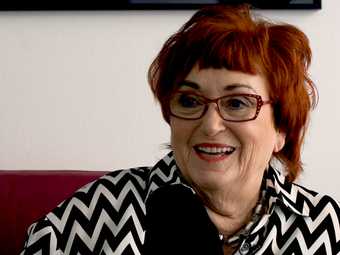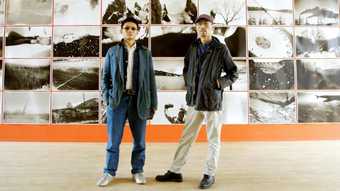[Nedko Solakov in his studio]: I do this ritual every morning when I enter the studio, every morning. And then I do this, all of this, and to do this for good luck, as I told you and because this one belongs to my wife, I always kiss this, and I kiss her socks like this.
Yeah I'm pretty superstitious. I know it's stupid. I mean it's you know all the time is because you try to keep control of things. In a way, I'm a control freak, I'm a control freak.
I moved to Sofia when I got married, which was in autumn of 85 and since that time, my studios they were here and, in a way, Sophia is part of my life.
[Nedko walking in the city, points to a building]: Yeah this was my - you see, the big window, the right-hand one, this was our mural painting studio. Let me call the dean to give us the permission to enter inside. And this is absolutely the same as it was in early 70s. I entered here in 75 and I graduated in 81.
[Nedko walks into his old art academy studio]. This is the mural painting studio
And this is me [shows a picture of his younger self standing in the studio], look at me as you see it yeah it is the same floor and my hair is almost the same.
I mean, it was a very conservative education but I still use, from my old professor Mito Ganovski, a saying, which was something like this: 'You, as an artist, it doesn't matter when you enter an architecture, even if they built architecture especially for your work of art, you're always the second. First it’s architecture’. As soon as you obey that rule there are no problems, at least for me.
[Artwork: Top Secret] My most famous or infamous piece is called Top Secret [1989-90]. In this piece, I was telling the story, a very personal story, which was like a real burden for me for a for a long time.
When I was in third year of the Academy, I was recruited by the Secret Service in Bulgaria. It was mainly kind of really talking about my fellow students. What kind of artists are they? Are there good artists? They don't have contacts with religious sects? And so and so.
And I was telling them very obediently and I felt I was something like the Bulgarian version of James Bond. But in 83, I said, ‘Please, no, I don't really want to be used anymore please. I still believed in socialism but then, step by step, thanks to Perestroika time, which started in the summer of 85, I started kind of realising in what I'm living in. And I made at least two paintings which were dedicated that story
[Nedko in front of one of his paintings]. You see me with the silhouettes, supposedly the Secret Service, holding this man down there. And there is a little bit of a hope, this kind of a slightly brightened future but this one is still really really, really black.
You have this burden; you try to take out that burden and make at least these two paintings then you do this piece Top Secret and it's a kind of a unique situation.
There is no such a dumb person who without being threatened to be disclosed [would] just reveal this. But, as soon as I had done this, I had the feeling that there are no barriers anymore in front of me, that I could do whatever I want.
Artwork: A View to the West]. View to the West became a sort of a legend, in a way, in contemporary Bulgarian art. It was done during an exhibition called the Earth and Sky, which happened on the roof terrace of the official union of artists. So, my work was consisting of this telescope, which was mounted on something. So, here is the parapet. Here there was a nice bronze plate; label written 'View to the West'. And then you had do that and then you look at and you see really the big red ruby star very beautiful, by the way, and this is exactly the West from the Eastern block. Before, ‘looking to the West’ that means you look into the capitalism, the desirable paradise or whatever but then - okay you're looking to the West, this West becomes closer but what actually becomes closer and you get even more attracted by, like swallowed by, is the red star.
It took some time, when I kind of convinced the art world that all of this visual diversity is done by one person and it is by one person because there is a common attitude behind that. And now when people ask me what I'm doing I say usually: 'I'm telling stories in space'.
[Nedko paints text on his wall]: Can you read it?
[Cameraman]: It's very small
[Text reads]: Complaining that it is too small.
Usually we think that the white cube is something which is ideal, it's perfect place to exhibit two or three dimensional artworks but when you come closer, you realise that actually it's not perfect, you have little cracks, you have little bubbles which they could become like a really nice valleys or little hills that my little fellows could live there.
I'm really using that principle which I learned back in my murals and this is also a mural. I'm using the space
[Artwork: A LIfe (Black & White) 1998 - ongoing]. The idea comes from 98. You have two painters: one is with white paint, the other one with black paint and these two painters, they're following each other so all the time, half of the space should be black, half of the space should be white.
I think the title explains quite a lot, it says: 'A Life (Black & White)', so the things become like real life. The black, presumably, the bad things they cover the white, the good things and vice versa.
And you realise that it's real absurd what you are doing but you keep doing it. Just what we do, all of us, living on that place called Earth.
We met up with Nedko Solakov in Sofia. The Bulgarian artist took us to his studios and the art academy where he studied mural painting. Today, he mixes his formal training with conceptual practices to create complex and witty works.



